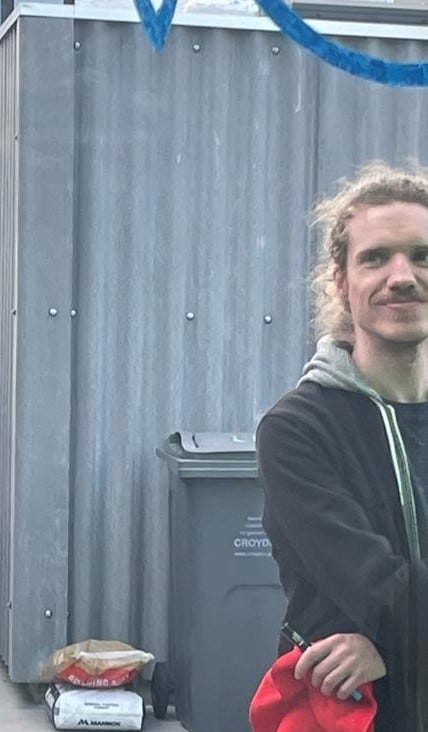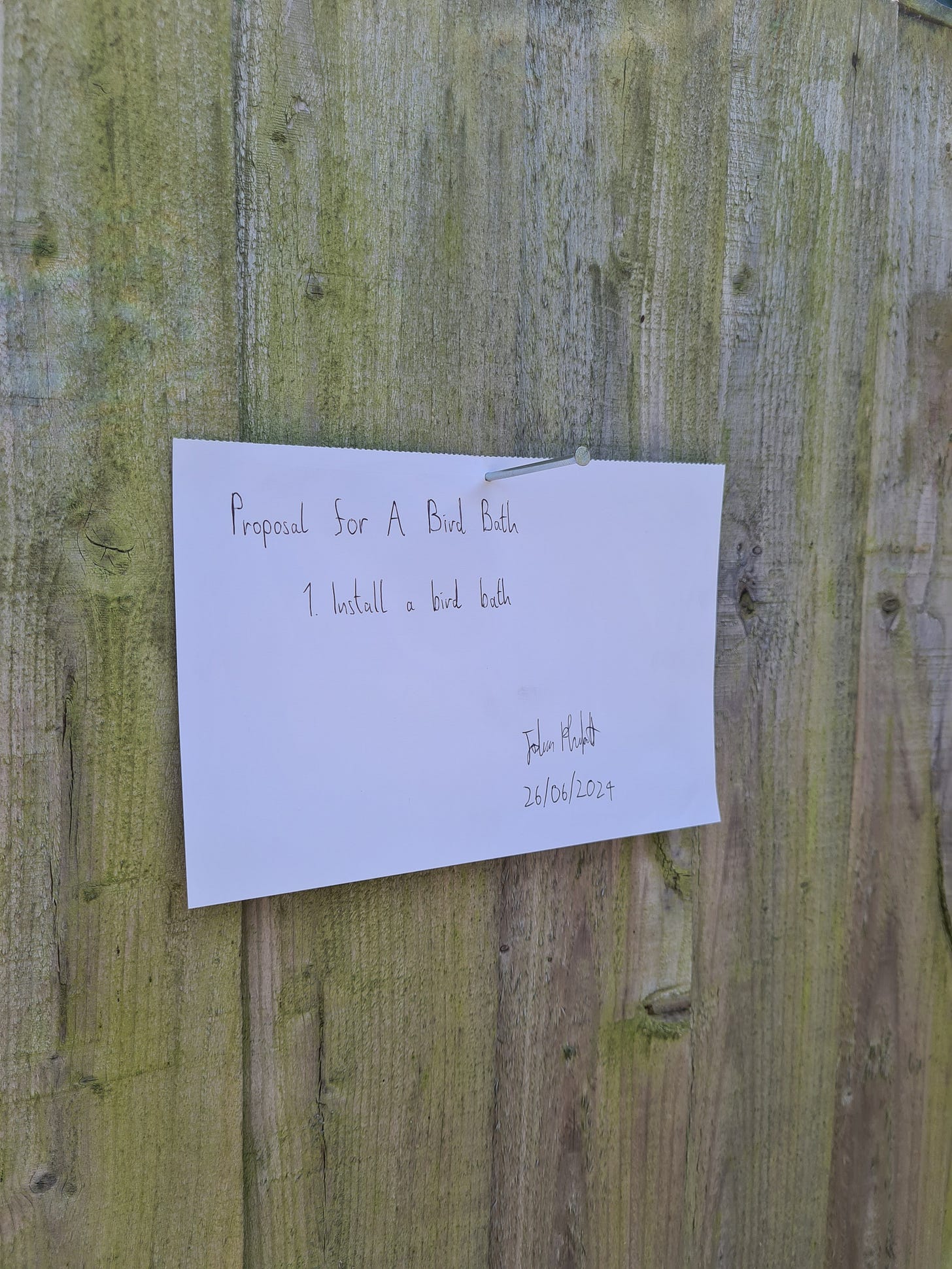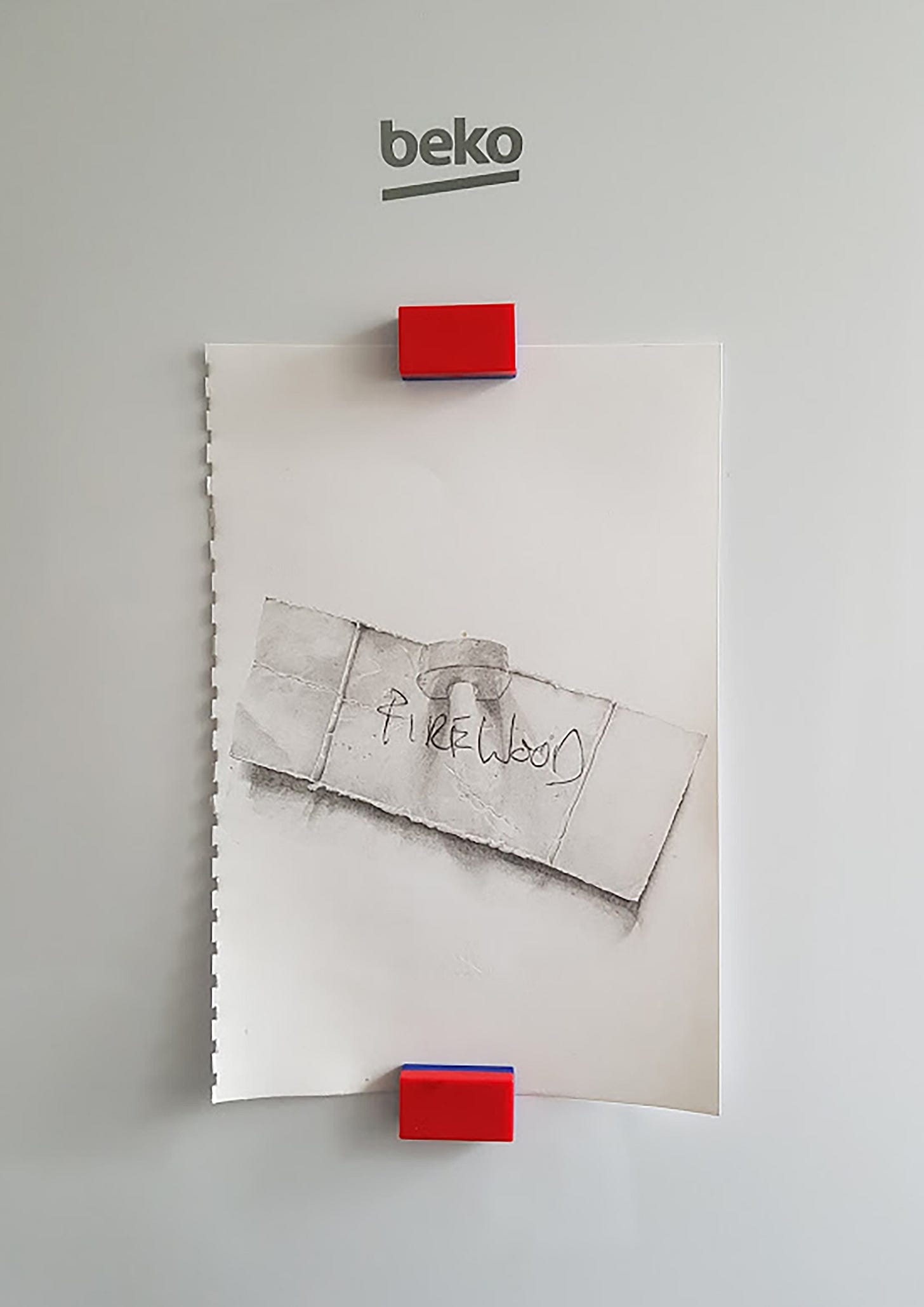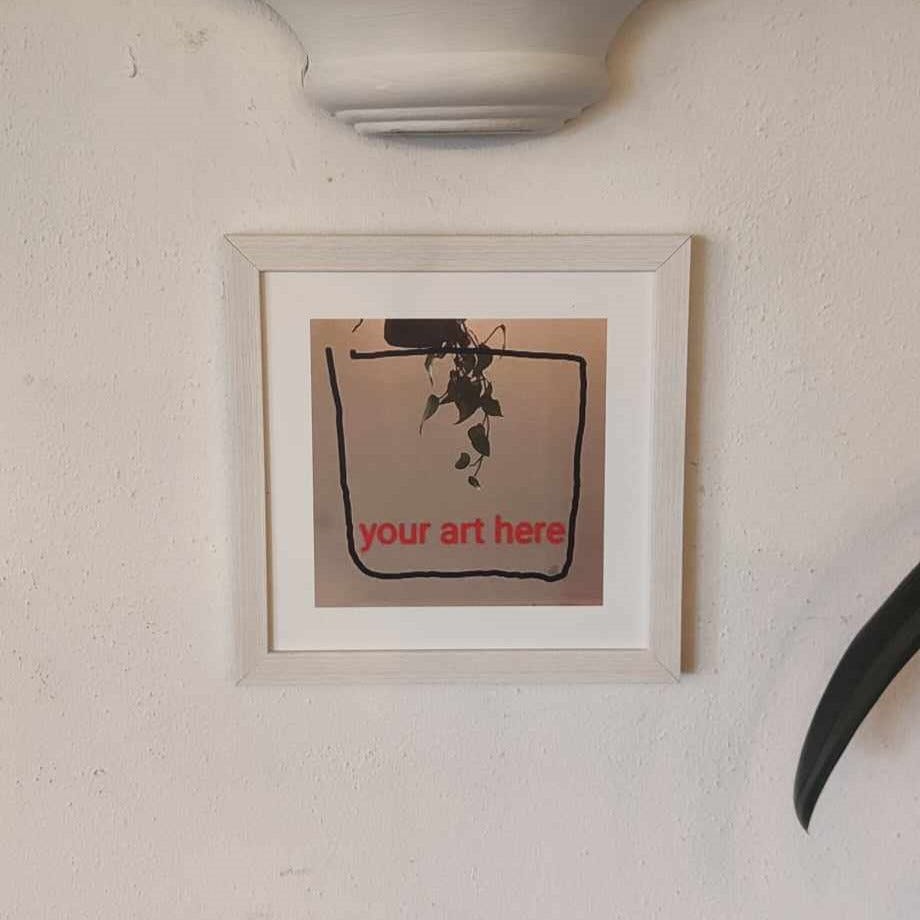It was late July and I was walking away from East Croydon station. I was looking for a green building. I didn’t know what kind of building it was. The roads I walked down were bleak, as were the houses and the industrial estates, all shrouded in a fine mist of rain. I hadn’t brought an umbrella. What was I doing here?
A month or so earlier, I had made an Instagram post about putting art in the cafe where I work. It was one of my first forays back on Instagram, a process that filled me with dread and fear and self-hatred, but I did it anyway. I needed art in the cafe. I took a few pictures of the cafe’s interior and exterior. On one of those pictures I drew a square, with ‘your art here’ written inside it, on a blank wall in the main seating area. Get in touch if you’re interested, I said, with a few choice emojis to show my irreverence. I published it, and sent the post to a few ‘artist opportunities’ Instagram accounts. One shared my post. A few days later, I got a message from an artist called Josh Philpott. He had suggested making my advert asking people to put art on the walls of the cafe into an artwork that he wanted put onto a wall in the cafe. I loved the idea, so I said sure.
That piece, Proposal for Your Art Here (The Mansion Bar & Cafe, Beckenham Place Park), is now on the left as you walk into the main seating area. It’s cute and clever and funny. Some people do think it’s purely instructional. During a quiet shift the other week, I overheard a woman say to her friend, “Ooh look Jenny, you can put your art in here. There’s a little thing in there that says so,” before they ordered their drinks.
Josh Philpott’s studio is in Conditions, a ‘low-cost studio programme’ housed in the aforementioned green building. By the time I found it, the rain had become torrential, so I texted Philpott and sheltered in a garage door. He came out to greet me, led me up to the top floor to make us some coffee, and then back downstairs to his studio. It was very white, very new, inside. He got me a desk chair to sit on and then sat opposite me. I reclined and asked him what he was working on.
He told me he was working towards three things. The closest one was going to be at the Institute of Contemporary Art, as part of a work in progress series run by Conditions. The upcoming show was all sound pieces.
“The thing I’m doing for it is - I mean I only tested this properly for the first time last week - a live self generated sound sculpture. It involves microphones set up, facing into the room, into the space. They’re recording live and playing through a delay pedal into speaker output, into the room, and the mics pick up the speakers’ output, and it goes back through, and it repeats. And it starts off imperceptible, and very gradually you hear it picking up what’s coming back through the speakers, and very softly it grows and builds into an ambient noisy crescendo which eventually takes over everything, it becomes very enveloping and very encompassing. And then you have to stop it before the walls shake, and then it gradually fades away and goes back to nothing.”
Philpott said he was also planning to show that piece at the Conditions end of year show, held in a disused shopping centre. That was the second thing he was working towards. The third was the next part of something called Growing Season, an exhibition series held by a collective called Coven. The first part was an open call exhibition held in the founders’ garden. That time, he “got a bit cheeky with it” and showed three things. First, he wanted to plant a ring of daisies in their garden, “but it turned out the garden was mostly stone and pebbles, rather than soil, so instead of doing a ring - ‘cause I quite like the form of a ring, fairy circles and such - I just ended up planting the daisies in plant pots that they had around.
“The second of three works was very simply a handwritten proposal on a small sheet of paper which was then nailed to the garden fence. It was just a proposal to install a bird bath, ‘cause I had this idea that I would get back into sculpture, which I studied and kind of gradually left behind, by building this bird bath which I would then go and install in part two - try and have an effect on the space and garden, encourage birds and wildlife to come along, and hopefully the daisies will do that with insects. I quite liked the parallel of those ideas and the parallel of the exhibition itself, encouraging people to come to the garden and congregate and socialise. Thinking about all of these are types of ecosystems.
“And the third thing was another new thing for me, which was a live reading on the day of unrealised proposals, things that I had written down and drawn up to show in the garden but didn’t do for one reason or another, and developed that into a kind of poem which was a repetitive, formulaic thing, where everything I read was a proposal. So the reading itself was a proposal, and everything I read out was a proposal. A proposal for work but also thinking about the nature of proposals in the context of making art, reading poetry or doing a thing or interacting or doing anything. It was quite nice. It gave me scope to play with it. It turned out really well, I think it helped that it was a beautiful sunny day.”
“We’re working backwards,” I said, “but how come you wanted to move away from sculpture?”
“Circumstance, really,” Philpott replied, “I graduated in 2016 from Camberwell, and as soon as you graduate, you suddenly don’t have the resources that were afforded to you at uni. You don’t have the space, you don’t have the workshops, you don’t have the equipment, and your student loan dries up. I didn’t have the normal trajectory as most graduate artists have, like, having a job, finding your own studio, and building up from there, because of my chronic illness. I have cystic fibrosis and I found it a real struggle to continue without support. I eventually found that I couldn’t really do it. I got on to the uni’s in-house job agency which you can go on for a year as a graduate, and I did a few odd jobs, and I got some volunteer work with this artist, as well. I showed my degree show work around for a year afterwards. I carried on like that, which was fine for a little while, but I realised I couldn’t hold down a job for any length of time without needing a period of recovery at best or a hospital stay at worst, so, then things just got more difficult. I realised that I couldn’t do this, then I started the process of getting on benefits, finding support through that. Then I had a period when I was ill and knocked out for a long time, and then I found Conditions, which seemed like a lifeline. It had been going for a year, this was 2019, I applied and got in and I thought, great, I can use this as a way to build back up. Yeah, that was exciting. And then Covid happened so I had to go away and shield for two years. I was with my mum in her cottage in Somerset. Home, back then, was in Peckham in this small flat and it just didn’t feel safe there when Covid was blowing up. I was like, I need to get out of here. Now. I was very fortunate that my mum was able to drive from Somerset and collect me. The day afterwards lockdown happened, very suddenly. Then it was just me there for the following two years.”
“It must have been quite frustrating,” I said.
“That’s one word for it. Yeah, it was very difficult because you didn’t know how long you would be there. Initially we thought this would be a few weeks at least, okay maybe a few months, okay it’s been a year now, okay it’s been two years now. When you normally go and stay somewhere, you know how long you’re staying there, so you can plan for that and get that in your head, knowing what you need to do. The lockdown seemed endless, but it did end. And there were periods of big openings which were celebrated and I was just like, me and many other disabled people in our shielding situations being like, great, good for you, except not, because inevitably the spreads gonna mingle and the numbers are gonna go back up again. Watching this, having no idea what’s gonna happen, it’s just… yeah so that was intense, but I was very fortunate that I could shield with my mum and her partner and my sibling. But it was very intense isolation.
“Once I had calmed down a little bit, I found I was able to laser focus on making one thing at a time. I got back into drawing, which I hadn’t done for a while, because I was studying sculpture. And that was really great, ‘cause I’m still drawing now. It was really nice to have that time and space to take my time with it. Focus on this one thing from conception to completion, and I’ve always been interested in the creative possibilities of limitations and restrictions, right? Shielding was the ultimate expression of that. I didn’t bring my computer with me, I just had my phone. And I had literally what was there in front of me and around me in the cottage basically to work with and work from.
“But handily, my mum’s partner, he writes notes to himself as reminders for things he has to do during the day. And he’ll write them on torn pieces of card from the back of medicine packaging. And he has this quite distinctive handwriting which I really liked. There was a note that he wrote for himself that just said ‘FIREWOOD’. And he put it on the fridge with a very classic, almost cartoony, fridge magnet - the red, horseshoe, type thing. And he put it on the fridge, it was a Beko fridge, and it looked great. So I took a photo on my phone, and I took that to the desk that my mum had given me, took some pencils out, and I just drew that. And I really enjoyed just drawing that. Just drawing that in detail was really soothing and really lovely and it kind of unlocked something. It was like, I’ve always been interesting in my surroundings and using my surroundings in my art anyway, that’s what I tried to do with my sculptures beforehand, but this was something else, I was really considering the situation I was in, the space I was in. I had drawn from the space, and I wanted, once I had completed the drawing, to put it back into the space, put it back onto my mums fridge. Which I also found quite funny, it’s quite a childish thing to do. I thought, huh, what if I lean into this? What if I carry on doing this? I made another drawing of another note and put it on the window of my mum’s cottage. Since I’ve come back I’ve thought, how can I continue working with spaces in similar ways? While on the one hand it’s been tempting to just carry on drawing and making drawings in the same way, I wasn’t very interested in just doing that, because I’m very distractible, I want to do all sorts of things. So I’m thinking of different ways I can affect and use a space, which has led to all sorts of things happening, which has been really great and interesting and unpredictable. So yeah, since graduating I’ve found, through circumstance, my practice has become more and more diffuse. But I really like that, I really like the diffuseness.”
“Do you want to talk about the piece you’ve given us?” I said.
“Yeah, that was quite a spontaneous one, really. Even more than the opportunity itself I was really intrigued by your image that you put on it. Like, I used it wholesale. It was just this square of this blank wall in your cafe, with this really satisfying peek of a plant just leaning in, and this, obviously really quickly done, hand-drawn red square digitally on top, with the ‘your art here’. I just loved that as a proposition and as an image in itself. I thought that I could submit or do a drawing or something, but I liked what had happened already, so I thought, why not just propose to show that? Especially this year, with proposals.”
I asked why proposals interested him.
“I’ve been thinking of proposals as works in themselves. So recently I came across the work of Ghislaine Leung, who’s really great. Learning about her practice, I love it, I love what she does, I love her work rate. She essentially doesn’t make anything, she writes these scores and sends them to galleries or places that she’s gonna work, and trusts the galleries to execute the scores and makes them happen, and that means that there’s inherent variation and site and situation specificity in each installation, each time it’s installed. I went to see her Turner Prize exhibition in Eastbourne this year, and that was great. One of the works that really stood out to me was a work called Fountain, which was ‘a score to install a fountain that cancels the noise’. I found it really poetic, as a piece of writing by itself, but what it meant in this exhibition, this installation, is that the gallery had set up a circular pool with a fountain in the middle, making this wonderful white noise that really filled the space - I’m fascinated by noise that fills the space, hence that sound piece I’m working on right now. I saw pictures online of another exhibition she did previously, which I think was in Switzerland or Sweden, but it was the same piece with the same score, but the way this gallery had installed it, they’d installed a pump and a water source on the gallery roof and had it falling through the skylight into the gallery space, into a drain directly below the skylight. And that was the whole piece. It was hitting the hard floor, and you can imagine the sound it was making. I found myself looking at the scores and considering the poetic nature of scores and proposals by themselves, so I’m trying to run with that at the moment. I think I’m fascinated by how each proposal and each score has built-in contingencies which affects how and if it works or comes to fruition.
“In my work I like to think and talk about it as poetry-adjacent, or poetry in itself. Drawing a note, a found word that’s been handwritten by someone else, that isn’t yours and you don’t know the context of, so it could mean anything to you, it clearly helped whoever wrote it, and exists in some context for them, but its not for you and you don’t know why they wrote what they wrote. So it’s just a random word, and it can be completely absurd. I think that’s a poetic discovery. I want to consider it like a way of writing poetry, that idea really interests me, writing poetry by other means, drawing someone else’s words, executing the score, or doing the proposal, things like that, yeah. It’s been really fulfilling for me.”
“Nice one!” I said. I thanked Philpott for his time and walked back into the rain.
****
You can see Josh Philpott’s (b. 1994, Birmingham) artwork ‘Proposal for Your Art Here (The Mansion Bar & Cafe, Beckenham Place Park)’ at the Mansion Bar and Cafe, Beckenham Place Park, south east London. If you want to get involved with the art in the cafe, message me. Cheers x






